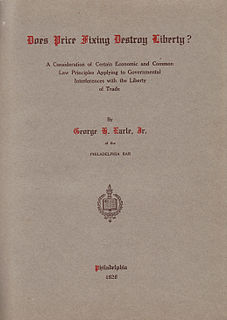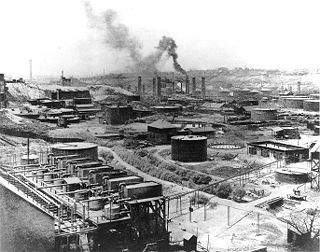
In the United States, antitrust law is a collection of mostly federal laws that regulate the conduct and organization of business corporations and are generally intended to promote competition and prevent monopolies. The main statutes are the Sherman Act of 1890, the Clayton Act of 1914 and the Federal Trade Commission Act of 1914. These acts serve three major functions. First, Section 1 of the Sherman Act prohibits price fixing and the operation of cartels, and prohibits other collusive practices that unreasonably restrain trade. Second, Section 7 of the Clayton Act restricts the mergers and acquisitions of organizations that may substantially lessen competition or tend to create a monopoly. Third, Section 2 of the Sherman Act prohibits monopolization.

Price fixing is an anticompetitive agreement between participants on the same side in a market to buy or sell a product, service, or commodity only at a fixed price, or maintain the market conditions such that the price is maintained at a given level by controlling supply and demand.

The list price, also known as the manufacturer's suggested retail price (MSRP), or the recommended retail price (RRP), or the suggested retail price (SRP) of a product is the price at which its manufacturer notionally recommends that a retailer sell the product.
Anti-competitive practices are business or government practices that prevent or reduce competition in a market. Anti-trust laws differ among state and federal laws to ensure businesses do not engage in competitive practices that harm other, usually smaller, businesses or consumers. These laws are formed to promote healthy competition within a free market by limiting the abuse of monopoly power. Competition allows companies to compete in order for products and services to improve; promote innovation; and provide more choices for consumers. Some business practices may be pro-competitive, economic methodological tests and empirical legal cases are used to test whether business activity constitutes as anti-competitive behavior.
The rule of reason is a legal doctrine used to interpret the Sherman Antitrust Act, one of the cornerstones of United States antitrust law. While some actions like price-fixing are considered illegal per se, other actions, such as possession of a monopoly, must be analyzed under the rule of reason and are only considered illegal when their effect is to unreasonablyrestrain trade. William Howard Taft, then Chief Judge of the Sixth Circuit Court of Appeals, first developed the doctrine in a ruling on Addyston Pipe and Steel Co. v. United States, which was affirmed in 1899 by the Supreme Court. The doctrine also played a major role in the 1911 Supreme Court case Standard Oil Company of New Jersey v. United States.
Resale price maintenance (RPM) or, occasionally, retail price maintenance is the practice whereby a manufacturer and its distributors agree that the distributors will sell the manufacturer's product at certain prices, at or above a price floor or at or below a price ceiling. If a reseller refuses to maintain prices, either openly or covertly, the manufacturer may stop doing business with it.
International Salt Co. v. United States, 332 U.S. 392 (1947), was a case in which the United States Supreme Court held that the Sherman Act prohibits as per se violations all tying arrangements in which a product for which a seller has a legal monopoly, such as a patent, requires purchasers to buy as well a product for which the seller has no legal monopoly.
Leegin Creative Leather Products, Inc. v. PSKS, Inc., 551 U.S. 877 (2007), is a US antitrust case in which the United States Supreme Court overruled Dr. Miles Medical Co. v. John D. Park & Sons Co.Dr Miles had ruled that vertical price restraints were illegal per se under Section 1 of the Sherman Antitrust Act. Leegin established that the legality of such restraints are to be judged based on the rule of reason.
Under a unilateral policy a manufacturer, without any agreement with the reseller, announces a minimum resale price and refuses to make further sales to any reseller that sells below the announced price. Unilateral policy is a form of resale price maintenance that enables a manufacturer to influence the price at which its distributors and dealers resell its products without a formal contract regarding the resale price. The policy was first identified in United States v. Colgate & Co., 250 U.S. 300 (1919).
Albrecht v. Herald Co., 390 U.S. 145 (1968), was a decision by the United States Supreme Court, which reaffirmed the law that fixing a maximum price was illegal per se. This rule was reversed in 1997 by State Oil Co. v. Khan, which held that maximum price-setting was not inherently anti-competitive and not always a violation of antitrust law, and should therefore be evaluated for legality under the rule of reason rather than a per se rule.
United States v. Univis Lens Co., 316 U.S. 241 (1942), is a decision of the United States Supreme Court explaining the exhaustion doctrine and applying it to find an antitrust violation because Univis's ownership of patents did not exclude its restrictive practices from the antitrust laws. The Univis case stands for the proposition that when an article sold by a patent holder or one whom it has authorized to sell it embodies the essential features of a patented invention, the effect of the sale is to terminate any right of the patent holder under patent law to control the purchaser's further disposition or use of the article itself and of articles into which it is incorporated as a component or precursor.
Eastman Kodak Co. v. Image Technical Servs., Inc., 504 U.S. 451 (1992), is a 1992 Supreme Court decision in which the Court held that even though an equipment manufacturer lacked significant market power in the primary market for its equipment—copier-duplicators and other imaging equipment—nonetheless, it could have sufficient market power in the secondary aftermarket for repair parts to be liable under the antitrust laws for its exclusionary conduct in the aftermarket. The reason was that it was possible that, once customers were committed to the particular brand by having purchased a unit, they were "locked in" and no longer had any realistic alternative to turn to for repair parts.

The history of United States antitrust law is generally taken to begin with the Sherman Antitrust Act 1890, although some form of policy to regulate competition in the market economy has existed throughout the common law's history. Although "trust" had a technical legal meaning, the word was commonly used to denote big business, especially a large, growing manufacturing conglomerate of the sort that suddenly emerged in great numbers in the 1880s and 1890s. The Interstate Commerce Act of 1887 began a shift towards federal rather than state regulation of big business. It was followed by the Sherman Antitrust Act of 1890, the Clayton Antitrust Act and the Federal Trade Commission Act of 1914, the Robinson-Patman Act of 1936, and the Celler-Kefauver Act of 1950.
Standard Oil Co. v. United States, 337 U.S. 293 (1949), more commonly referred to as the Standard Stations case to distinguish it from a 1911 case with the same caption, Standard Oil Co. v. United States, is a 1947 decision of the United States Supreme Court in which requirements contracts for gasoline stations were held to violate section 3 of the Clayton Act. That statute prohibits selling goods on the condition that the customer must not deal in the goods of a competitor of the seller, such as in a requirements contract, if the effect is to "substantially lessen competition" or "tend to create a monopoly." The doctrine of this case has been referred to as "quantitative substantiality," and its exact contours were unsettled and controversial for many years until the Supreme Court authoritatively explained it in United States v. Philadelphia National Bank.
United States v. Parke, Davis & Co., 362 U.S. 29 (1960), was a 1960 decision of the United States Supreme Court limiting the so-called Colgate doctrine, which substantially insulates unilateral refusals to deal with price-cutters from the antitrust laws. The Parke, Davis & Co. case held that, when a company goes beyond "the limited dispensation" of Colgate by taking affirmative steps to induce adherence to its suggested prices, it puts together a combination among competitors to fix prices in violation of § 1 of the Sherman Act. In addition, the Court held that when a company abandons an illegal practice because it knows the US Government is investigating it and contemplating suit, it is an abuse of discretion for the trial court to hold the case that follows moot and dismiss it without granting relief sought against the illegal practice.
Otter Tail Power Co. v. United States, 410 U.S. 366 (1973), is a United States Supreme Court decision often cited as the first case in which the Court held violative of the antitrust laws a single firm's refusal to deal with other firms that denied them access to a facility essential to engaging in business.
United States v. Terminal R.R. Ass'n, 224 U.S. 383 (1912), is the first case in which the United States Supreme Court held it a violation of the antitrust laws to refuse to a competitor access to a facility necessary for entering or remaining in the market. In this case a combination of firms carried out the restrictive practice, rather than a single firm. That made the conduct susceptible to challenge under section 1 of the Sherman Act rather than under the heightened standard of section 2 of that act, but the case was brought under both sections.
Lorain Journal Co. v. United States, 342 U.S. 143 (1951), is a decision of the United States Supreme Court often cited as an example of a monopolization violation being based on unilateral denial of access to an essential facility, although it in fact involved concerted action. When the Lorain Journal's monopoly over advertising in the Lorain, Ohio area was threatened by the establishment of a competing radio station, the Journal's publisher refused to accept advertising from those who advertised over the radio station and required them to advertise only in the Journal. The purpose of the publisher was to eliminate the competition of the radio station. The Supreme Court held that the publisher had attempted to monopolize trade and commerce, in violation of § 2 of the Sherman Antitrust Act, and was properly enjoined from continuing the conduct.
A hub-and-spoke conspiracy is a legal construct or doctrine of United States antitrust and criminal law. In such a conspiracy, several parties ("spokes") enter into an unlawful agreement with a leading party ("hub"). The United States Court of Appeals for the First Circuit explained the concept in these terms:
In a "hub-and-spoke conspiracy," a central mastermind, or "hub," controls numerous "spokes," or secondary co-conspirators. These co-conspirators participate in independent transactions with the individual or group of individuals at the "hub" that collectively further a single, illegal enterprise.
Klor’s, Inc. v. Broadway-Hale Stores, Inc., 359 U.S. 207 (1959), is a United States Supreme Court decision holding that a retail chain's persuasion of a number of suppliers not to deal with a competitive retailer was a per se illegal boycott – under a hub-and-spoke conspiracy theory.




